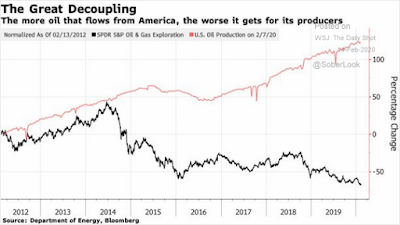These Are Not the Earnings We're Looking For, Part XL
Oil and gas prices finished 2019 at $61.21 and $2.18. Yet cash and working capital continued to be the predominant issue in the industry. Paying creditors at some of the producers appears to be an issue as well as the third quarter trend of ballooning accounts receivable continues. This can only be the result of the producers working interest partners suspending, on a wholesale basis, the payments of their Joint Interest Billings, the amounts of capital and operations that are incurred on behalf of the partnership by the operators. The service industry has been forced to extend credit to the longest known pay cycles known to man, all as a result of this cash crisis. Now the producers are betraying the trust of their partners in these properties. I can only speculate what the consequences of this activity will have over the mid to long term. I think it confirms that the prospects of the bureaucratically managed business of the oil and gas producers is untenable. Trust with the service industry and their producer partners is being actively eroded through this ongoing financial crisis.
Earnings are always a feature in oil and gas. As they were throughout 2019. The fourth quarter did see a loss of $7.8 billion however the year came in at a profit of $14.6 billion. A decline from 2018 earnings of $21.7 billion. This was miraculously achieved even with a 2019 $23.7 billion decline in revenues over 2018. I don’t know how these bureaucrats continue to perform as well as they do! The difficulty however is of course they’ve consumed cash at an annual rate of $7.0 billion. Due primarily to the annual cash flow being $74.3 billion and invested cash flow being $80.5.
One of People, Ideas & Objects claims is that producers need to cost their capital and operations appropriately into the commodity prices they charge consumers. These prices should never be unprofitable anywhere or at any time in North America. The Preliminary Specification decentralized production models price makers strategy provides for this. We believe that the property, plant and equipment account is bloated beyond all sense and recognition of reality. Deceiving investors has required producers to “build balance sheets” as opposed to running businesses. Therefore the need to draw down these balances as a requirement, and People, Ideas & Objects recommend that the industry take a competitive posture in terms of providing a return on investment that competes with other industries. Therefore 2.5 years is what we believe the balances of property, plant and equipment should be extinguished by in terms of calculating the commodity transfer prices to the consumers. It is in that sense that we assumed “what if” the current producers in our sample began to provide this method of accounting based on all others being equal. This calculation shows that these producers had lost $57.0 billion in 2019. Up, or is that down, from a loss of $43.4 billion in 2018. Somehow, saying you lost $100 billion in the past two years seems more consistent with these producers performance, and a number that has an inherently higher level of integrity than a “profit” of $36.5 billion for 2018 and 2019.
When we look at the bloated nature of the property, plant and equipment account. Apply what we believe to be a reasonable reassessment of what is assets and what are the unrecognized costs of past production. We then, on a pro-forma basis, move 65% of property plant and equipment to depletion to better state the affairs of the producer and industry. We see that the debt leverage is completely outside of any acceptable range. Instead of 31% as it stands today, the level of secure debt would be 88%. Considering total debt and total assets the factors become 55% debt to total assets today, and 113% on a proforma basis. It is our opinion that calling the unrecognized capital costs of prior production property, plant and equipment on the balance sheet is inappropriate. Therefore we feel our adjustment brings the overstatement of assets and earnings in line with the actual performance of these producers. The issue arising as a result of this pro-forma recognition is the debt levels of the industry, as represented by our sample of 20 producers, is untenable.
Another factor that we find interesting is the low percentage of working capital / annualized cash flow. For 2020 it stands at 7.304% down from its most recent high of 64.43% in the third quarter of 2016. Odd isn’t it, that was about the time the investors began their march out the door! They say the trend is your friend but I think that producers should look for a new peer group. These ones aren’t doing them much good. Bureaucrats thought they could tread water for the foreseeable future. That is not going to happen. The deterioration of cash and working capital continues and the situation has become such that they are financially damaged to the point where banks, creditors and investors have lost all interest and have begun running the other way. Organizations seeking working capital, who appear to have chronic working capital issues are special kinds of organizations. They’re sometimes referred to as failures. Primarily because they are and they’ll have few opportunities to remediate themselves.
The Preliminary Specification, our user community and service providers provide for a dynamic, innovative, accountable and profitable oil and gas industry with the most profitable means of oil and gas operations. Setting the foundation for profitable North American energy independence. People, Ideas & Objects have published a white paper “Profitable, North American Energy Independence -- Through the Commercialization of Shale.” that captures the vision of the Preliminary Specification and our actions. Users are welcome to join me here. Together we can begin to meet the future demands for energy. And don’t forget to join our network on Twitter @piobiz anyone can contact me at 403-200-2302 or email here.







